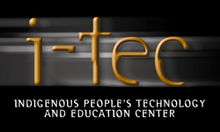Indigenous People's Technology and Education Center
 | |
| Abbreviation | I-TEC |
|---|---|
| Formation | 1996 |
| Type | 501(c)(3) not-for-profit |
| Location | |
President | Steve Saint |
| Website | http://web.archive.org/web/20070819091642/http://itecusa.org:80/ |
Indigenous People’s Technology and Education Center (I-TEC) is a 501(c)(3) not-for-profit Christian missionary organization located in Dunnellon, Florida. Founded by Steve Saint, the stated purpose of I-TEC is to empower indigenous churches to overcome the technological and educational hurdles that stand in the way of their independence."[1]
History
I-TEC was founded by Steve Saint, son of missionary Nate Saint, as a result of his experiences living among the Huaorani in the Amazon rainforest in Ecuador, near Shell Mera.[2] In 1996, 18 months after moving to the tribal village at the request of the Huaorani elders, including Mincaye, to guide their interactions with the outside world, Saint moved back to the United States, so as to prevent the tribe from becoming detrimentally dependent on him.[3] Upon his return to the United States, he founded I-TEC with the ambition to develop solutions to the economic and cultural crises that the Huaorani and many other tribal cultures face, using technology that indigenous people can operate and maintain with minimal outside support.[4] Steve Saint has worked extensively with the Huaorani and insists, “I only do what the Waodani have asked me to do. I would just as soon they live in their old culture—without the killing. But that really isn't for me to decide. The people in the culture who have to live with the ramifications of the change are the ones who should decide.”[5]
I-Fly Maverick

Developed by I-TEC, the I-Fly Maverick is designed to be an easy-to-use ground and aerial vehicle. According to Popular Mechanics, the Maverick "looks like a dune buggy, but one with a propeller in back like an Everglades airboat and, billowing above, a rainbow colored flex wing … held aloft on a mast."[6] Equipped with the largest powered parachute available, the Maverick was first accepted by the Federal Aviation Administration as an experimental aircraft on April 14, 2008.[7]
Capable of interstate speeds on pavement, the Maverick's dune buggy-like frame of chromoly tubing gives it the ability to be used off-road. Additionally, the vehicle can deploy a parafoil and fly as a powered parachute. It weighs about 1100 pounds and has a useful carrying capacity equivalent to a Cessna 172 (fuel and 550 pounds cargo). With a 22-foot mast, the Maverick can take off and land in weather conditions that other powered parachutes would not be able to safely handle. Steve Saint has said he envisions the Maverick being useful to the Huaorani and other Indian groups, farmers and ranchers, pipeline inspection crews, and anyone else needing to traverse rough, roadless ground.[6] Popular Mechanics gave it their Breakthrough Award in 2009.[8]
Additional projects
In addition to the Maverick, I-TEC is working on a number of additional projects. It has developed a program called "I-Dent" to train native Huaorani to perform basic dental procedures using a lightweight portable dental chair,[6] with the goal of improving dental conditions in the local Amazonian bush villages.[4] I-TEC states that the chair has also been used in Romania, Chad, Patagonia, and Burma.[9] Founder Steve Saint states that they have a similar effort called "I-See," which aims to train indigenous corrective lenses vendors to be self-sustaining and to increase the availability of affordable glasses in frontier and impoverished areas.[10]
References
- ↑ "I-TEC Website". Retrieved 2009-06-02.
- ↑ Martin, Allie (10 June 2003). "Forgiveness of Father's Killers Made Possible Through Christ". Agape Press. Retrieved 2009-06-01.
- 1 2 Wood, Rick (May–June 1998). "Fighting Dependency Among "the Aucas"" (PDF). Mission Frontiers Bulletin. Retrieved 2009-06-01.
- ↑ Knoke, Amanda (Jan 2006). "A Conversation With Steve Saint: For the Love of a Tribe ...". Decision Magazine. Retrieved 2009-06-01.
- 1 2 3 Ward, Logan (May 2009). "New Flying Car Aims to Save Lives in the Amazon". Popular Mechanics. Retrieved 2009-06-01.
- ↑ FAA N-number registry
- ↑ Bolduan, Kate (2010-10-27). "Missionary builds flying car, FAA certifies it". CNN. Retrieved 2010-10-30.
- ↑ Saint, Steve. "Testimonials". I-TEC. Retrieved 2009-06-16.
- ↑ Saint, Steve. "Indegenous Sight Enhancement Program". I-TEC. Retrieved 2009-06-02.
External links
- I-TEC Official Site
- Interview of Steve Saint, along with footage of the Maverick in flight, from the Experimental Aircraft Association.